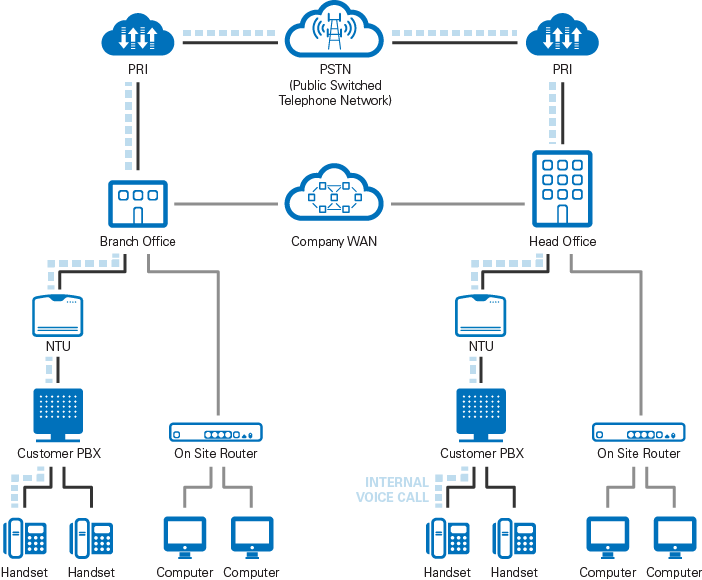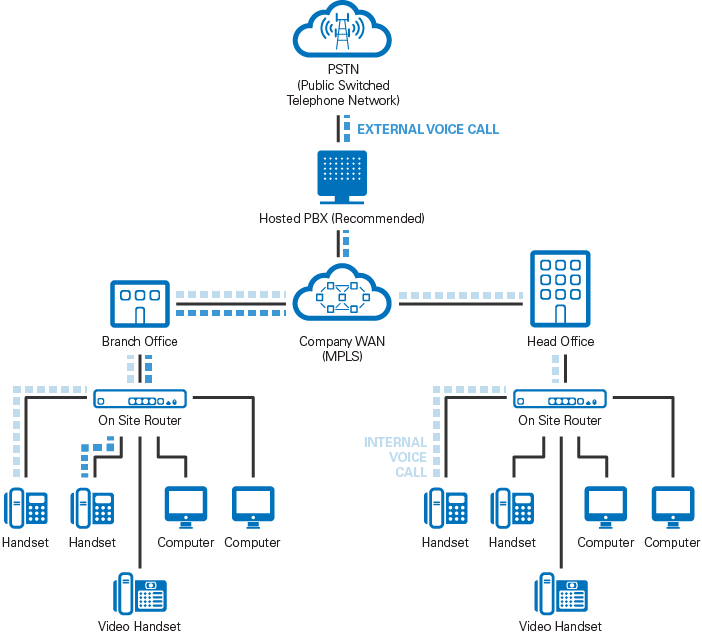
5 Major Advantages of SIP over ISDN
For those who aren’t particularly familiar with the ins-and-outs of SIP and ISDN, the distinctions can be confusing and often outdated. To help clear things up we’ll start with the basics and move on from there. SIP or Session Initiation Protocol is an application layer protocol that is based on IP. Without getting into the gritty details too much, it’s more or less the communication standard responsible for VoIP (Voice over IP) telephony. Whereas ISDN (Integrated Services for Digital Network) is a much older communication standard designed for the transmission of voice traffic over traditional phone networks.
In practical terms, both services are delivered in a similar way, and can achieve similar levels of reliability. However, in an ISDN deployment (Diagram 1), businesses are required to pay for and run both a voice service (indicated by the dark grey line) in addition to their data services (indicated by the light grey line). Whereas in a SIP deployment (Diagram 2) a converged network can be used for both voice and data services, creating significant savings for businesses.
Diagram 1: ISDN based call routing

Diagram 2: SIP based call routing

There are a myriad of advantages that SIP can offer businesses over ISDN, and we’ve outlined a few of the major ones below.
1. Scalability
ISDN services are typically limited to the channel blocks in which they are bought (typically 2, 10, 20, or 30), whereas SIP is deployed across a business’s existing WAN. This means that provided the bandwidth exists to handle the traffic, channels can be dynamically added or subtracted as they are required. This has the advantage of limiting the amount of unused overhead that has to be purchased in an ISDN model, as well as allowing the business to be able to ramp up the number of SIP channels within minutes, as opposed to the days or weeks required for ISDN.
2. Portability
In a typical Australian ISDN deployment the line and channel block comes with an allocated phone number. The rental charges for which are automatically factored into the cost of the ISDN, whether or not it is needed.
In a SIP based service, numbers are separate from the channel blocks, which has the benefit of helping to lower the cost of the service. However, the main benefit is derived from the fact that the phone numbers are not tied to physical locations. This means that calls to SIP numbers can be diverted incredibly easily to other locations. Typically this is done as an automatic failover between multiple office sites, allowing calls for one site to be answered by another site when all the lines are busy.
This same functionality also allows numbers to be redirected in disaster recovery situations. For instance, if a business’s premises were to flood, the phone lines could easily be redirected to a single (or multiple) recovery sites until such time as the service could be restored.
3. Interoperability
SIP voice is transferred as IP (Internet Protocol), this means that customers with video enabled handsets can make video calls. Although, this kind of functionality is available on an ISDN service – some of the more tenured readers may remember the Telstra Megalinks of the late 90’s and early 2000’s – the bandwidth requirements of video over ISDN make this an economically unjustifiable option in today’s marketplace.
4. Quality
Because SIP can be delivered across high bandwidth connections (such as Ethernet over Fibre or Copper) higher levels of vocal quality can be delivered from end to end. This means that customers can make and receive HD quality voice calls, assuming of course their hand sets are compatible. Additionally, with services not necessarily relying on a single connection, SIP services could utilise a primary service with automatic failover to a second path, which is not available on ISDN.
5. Price
The bottom line is what it often comes down to for businesses, and for the reasons outlined above SIP almost always wins out over ISDN.
One of the biggest benefits of a SIP based solution rather than an ISDN solution is illustrated by the dashed lines in Diagrams 1 and 2 above. In an ISDN solution an internal call (ie. a call from one site office to another) is required to traverse the PSTN (Public Switched Telephone Network) in order to reach its destination. This comes at a cost to the business because it is handled the same as any other call. Additionally, it also requires the purchase of a PRI (Primary Rate ISDN) for each of the sites.
In a SIP deployment the call remains within the business’s MPLS network and is therefore able to avoid the charges for call handoffs by their telecommunications provider. Although external calls will still need to be handed off to the PSTN, because SIP traffic is IP based it is capable of traversing the company’s own MPLS WAN and being handed off without the need to purchase PRI’s.
Even for small businesses this can add up to a lot of savings. Exact figures will obviously vary from business to business, but if you are still using an ISDN based service we would recommend having a chat to your service provider to see what opportunities are available.
To find out more about Telarus’ SIP based voice platform please contact us.



